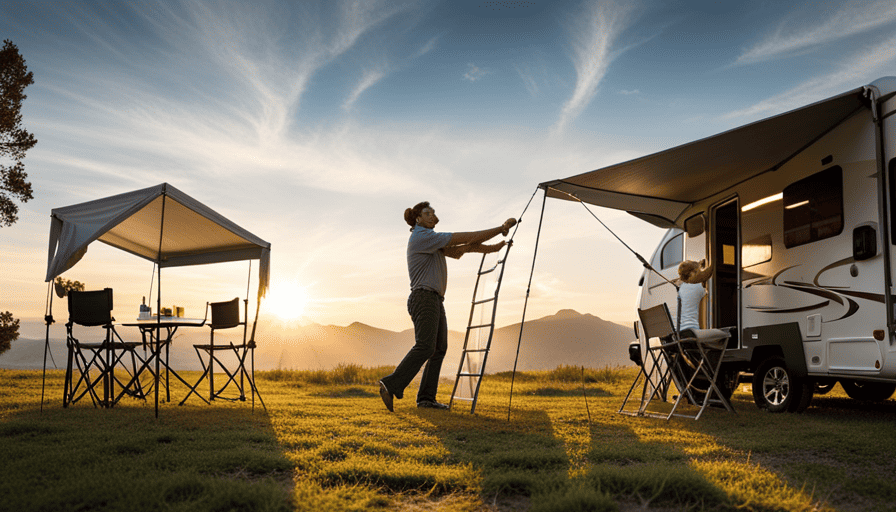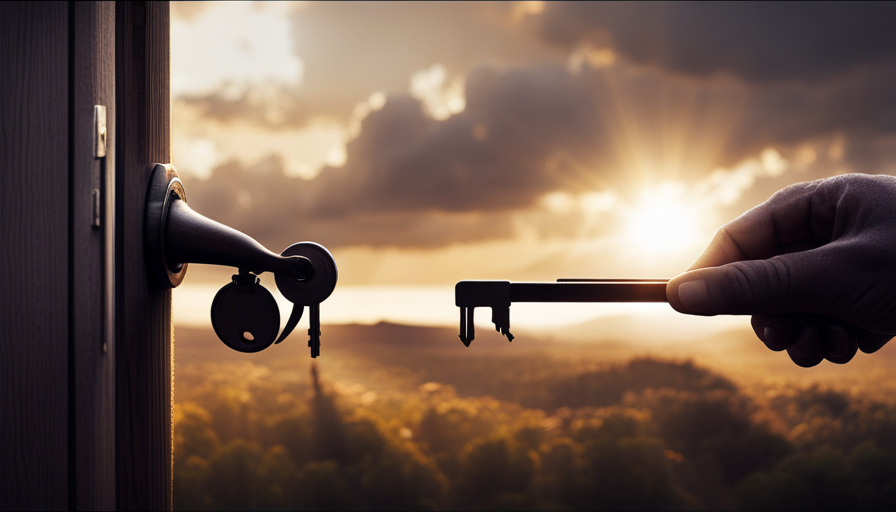Were you aware that nine out of ten camper owners face battery problems during their travels? It’s extremely aggravating to be deep in nature and suddenly have your camper’s battery give out. However, there’s no need to worry, as I’m going to show you the right way to charge your camper battery successfully.
In this article, I will provide you with step-by-step instructions on how to charge your camper battery using various methods. Whether you have a deep-cycle battery or a lithium-ion battery, this guide will cover it all.
You will learn how to gather the necessary equipment, connect your battery to a power source, and use a battery charger to ensure a full charge. We will also explore alternative methods such as utilizing solar power or a generator for charging.
Additionally, I will share tips on how to monitor your battery charging progress and practice proper battery maintenance. And in case you encounter any common charging issues, I will provide troubleshooting techniques to get you back on track.
So let’s dive in and ensure that your camper battery stays charged throughout your adventures!
Key Takeaways
- Understanding the different types of camper batteries: lead-acid, lithium-ion, AGM
- Exploring alternative methods for charging: solar power and generators
- Importance of monitoring battery charging progress and maintenance
- Troubleshooting techniques for common charging issues
Understand Your Camper Battery Type
Now that you’ve got your camper battery, let’s dive in and understand what type it is so you can charge it up and get back on the road in no time!
Camper batteries come in different types, and it’s essential to know which one you have to ensure you charge it correctly. The most common types of camper batteries are lead-acid, lithium-ion, and AGM (Absorbent Glass Mat).
Lead-acid batteries are the traditional choice, known for their reliability and affordability. Lithium-ion batteries are gaining popularity due to their lightweight design and longer lifespan. AGM batteries are a newer technology that offers a maintenance-free option with excellent performance.
Another crucial factor to consider is the battery capacity, which is measured in amp-hours (Ah). This indicates how much energy the battery can store and deliver. Higher capacity batteries will last longer before needing a recharge.
Knowing your battery type and capacity will help you determine the appropriate charging method and duration.
Now that you understand your camper battery type and capacity, let’s move on to the next step: gathering the necessary equipment to charge it up.
Gather the Necessary Equipment
First, you’ll need to gather all the essential equipment to get your camper’s battery up and running again. Here’s a list of the equipment you’ll need:
-
Battery charger: Make sure you have a charger that’s compatible with your camper battery type. It’s important to choose a charger that has the right voltage and amperage for your battery.
-
Safety goggles and gloves: Safety should always be a priority when working with batteries. Protect your eyes with goggles and your hands with gloves to prevent any accidents or injuries.
-
Wrench or screwdriver: Depending on your camper’s battery setup, you may need a wrench or screwdriver to disconnect the battery terminals.
-
Battery terminal cleaner: Over time, battery terminals can become corroded and affect the battery’s performance. Use a battery terminal cleaner to remove any corrosion and ensure a good connection.
-
Battery terminal brush: A battery terminal brush will help you clean the battery terminals effectively and remove any dirt or grime.
Before you start working on your camper battery, it’s important to take some safety precautions. Make sure to turn off all electrical devices in your camper and disconnect any power sources. Additionally, make sure you’re working in a well-ventilated area to avoid inhaling any potentially harmful fumes.
Now that you have gathered all the necessary equipment and taken the required safety precautions, it’s time to connect your camper battery to a power source.
Connect Your Camper Battery to a Power Source
Once you’ve gathered all the necessary equipment, it’s time to hook up your camper battery to a power source and get things rolling.
There are a few power source options available for charging your camper battery. One option is to use shore power, which is when you connect your camper to an external power source at a campground or RV park. This allows you to charge your battery directly from the electrical grid.
Another option is to use a portable generator, which provides a reliable power source when you’re not near a campground. Just make sure to follow the manufacturer’s instructions and safety precautions when using a generator.
It’s important to note that regardless of the power source you choose, you should always exercise caution and follow safety guidelines. This includes wearing protective gear, such as gloves and safety glasses, and ensuring that all connections are secure and free from damage. Taking these safety precautions will help prevent accidents and ensure a smooth charging process.
Now, let’s move on to the next section where we’ll discuss how to use a battery charger.
Use a Battery Charger
To get your power flowing, all you need is a trusty battery charger. When it comes to charging a camper battery, using a battery charger is a simple and effective method. A battery charger is designed to provide the necessary charge to your battery and ensure its optimal performance.
To understand the process better, let’s take a look at the following table:
| Step | Procedure |
|---|---|
| 1 | Connect the battery charger to a power source. |
| 2 | Identify the positive and negative terminals on your battery. |
| 3 | Connect the positive charger clamp to the positive terminal of the battery. |
| 4 | Connect the negative charger clamp to the negative terminal of the battery. |
| 5 | Set the charger to the appropriate charging mode and voltage. |
| 6 | Start the charging process and monitor the progress. |
| 7 | Once the battery is fully charged, disconnect the charger from the power source and remove the clamps from the battery terminals. |
When it comes to battery maintenance and troubleshooting issues, a battery charger can also be a valuable tool. It allows you to test the battery’s voltage, diagnose any charging problems, and even revive a dead battery in some cases.
Now that your battery is charged, let’s explore how to utilize solar power for charging.
Utilize Solar Power for Charging
Contrarily, harnessing the power of the sun can provide a sustainable and eco-friendly solution for replenishing your power supply while on the road.
To utilize solar power for charging your camper battery, you’ll need to install solar panels on the roof of your vehicle. These panels will absorb sunlight and convert it into electricity, which can then be used to charge your battery. When installing the solar panels, make sure they’re securely mounted and positioned to receive maximum sunlight exposure throughout the day.
Calculating your solar power requirements is crucial to ensure efficient charging. Start by determining your daily power consumption, which includes all the appliances and devices you plan to use in your camper. Once you have this information, you can calculate the size and number of solar panels needed to generate enough electricity to meet your needs. It’s also important to consider the battery capacity and efficiency, as well as the location and climate conditions you’ll be traveling in.
By utilizing solar power, you can significantly reduce your reliance on traditional power sources and minimize your carbon footprint. Taking advantage of alternator charging, which we’ll discuss in the subsequent section, can further enhance your camper battery charging capabilities.
Take Advantage of Alternator Charging
Maximize the power of your camper’s engine by tapping into the energy generated by the alternator, allowing you to keep your devices powered up while on the road. Alternator charging is an efficient way to charge your camper battery and offers several benefits:
-
Increased efficiency: The alternator is designed to generate electricity while the engine is running, making it a reliable source of power for charging your camper battery. This eliminates the need for additional equipment or relying solely on solar power.
-
Faster charging: The alternator has a higher output capacity compared to solar panels, allowing for faster charging of your camper battery. This is especially useful when you have limited time or need to quickly recharge your battery.
-
Continuous power supply: Unlike solar power, which is dependent on sunlight, the alternator can charge your battery continuously as long as the engine is running. This ensures a steady power supply for your devices, even on cloudy days or during nighttime travel.
-
Cost-effective solution: Utilizing the alternator for charging eliminates the need for additional investments in solar panels or generators. This makes it a cost-effective solution for keeping your camper battery charged.
Considering the benefits of alternator charging, it’s a reliable and efficient method to keep your camper battery powered while on the road. However, it’s also important to consider a generator for charging, which will be discussed in the subsequent section.
Consider a Generator for Charging
Another option to harness even more power for your camper’s electrical needs is by considering the use of a generator. A generator can provide a reliable source of electricity to charge your camper battery, especially when you’re camping in remote locations without access to shore power.
When choosing a generator, it’s important to consider the type of fuel it uses. Most generators run on gasoline, but there are also propane and diesel options available. Gasoline generators are generally more common and convenient, but they can be noisy and require frequent refueling. Propane generators, on the other hand, are quieter and produce fewer emissions, but they may require a separate propane tank. Diesel generators are known for their efficiency and durability, but they can be more expensive.
One thing to keep in mind when using a generator is the noise pollution it may create. Generators can be quite loud, especially if you’re camping in a quiet and peaceful environment. To minimize noise pollution, you can place the generator away from your campsite or use a soundproof enclosure. Additionally, some generators come with built-in noise reduction features.
As you consider using a generator for charging your camper battery, it’s important to monitor your battery charging progress. This’ll help ensure that your battery is being charged properly and prevent overcharging or undercharging.
Monitor Your Battery Charging Progress
Keep an eye on the progress of your battery charging to ensure optimal performance and avoid any potential issues. Monitoring systems are essential for maintaining your camper battery’s health. Here are three reasons why monitoring your battery charging progress is crucial:
-
Real-time Data: A monitoring system provides real-time information about your battery’s voltage, current, and state of charge. This data allows you to track the charging process and make informed decisions.
-
Early Warning Signs: By monitoring your battery, you can detect any abnormalities or signs of deterioration early on. This enables you to address potential issues before they become major problems, saving you time and money.
-
Optimal Charging: A monitoring system ensures that your battery is charged correctly. It helps you find the right balance between undercharging and overcharging, which can significantly impact battery longevity.
By closely monitoring your battery charging progress, you can prevent premature battery failure and maximize its lifespan. However, monitoring alone isn’t enough. To practice proper battery maintenance, it’s essential to follow a few additional steps to keep your camper battery in top shape.
Practice Proper Battery Maintenance
To ensure the longevity of your camper battery, it’s important that you regularly perform maintenance tasks. These include checking the electrolyte levels, cleaning the terminals, and tightening the connections. Battery maintenance tips are crucial to prevent battery deterioration and ensure optimal performance during your camping adventures.
Firstly, check the electrolyte levels regularly by removing the cell caps and using a hydrometer to measure the specific gravity. If the levels are low, add distilled water to bring them up to the recommended level.
Additionally, inspect the battery terminals for any signs of corrosion. Corroded terminals can hinder the flow of electricity and lead to diminished performance. Clean the terminals using a solution of baking soda and water, and a wire brush if needed.
Lastly, ensure all connections are tight and secure to maintain proper electrical flow.
By following these battery maintenance tips, you can prevent battery deterioration and avoid potential issues while on the road.
Moving on to the next section, let’s troubleshoot common charging issues and find solutions for uninterrupted power supply on your camping trips.
Troubleshoot Common Charging Issues
Experiencing issues with your camper’s power supply? Let’s dive into troubleshooting common charging problems for uninterrupted camping adventures!
When it comes to troubleshooting battery issues in your camper, there are a few common problems that you may encounter. One issue could be a faulty connection between the battery and the charger. To fix this, check all the connections and ensure they’re secure and free from corrosion.
Another common problem is a low battery voltage, which can be caused by a discharged battery or a defective charger. To optimize charging efficiency, make sure to fully charge the battery before each trip and use a charger specifically designed for deep-cycle batteries. Additionally, check the charger’s output voltage to ensure it matches the battery’s specifications.
If you’re still experiencing issues, it may be necessary to replace the battery or charger. Remember to always follow the manufacturer’s instructions and consult a professional if you’re unsure.
By troubleshooting common charging issues and optimizing charging efficiency, you can ensure a reliable power supply for your camper and enjoy uninterrupted camping adventures.
Frequently Asked Questions
How long does it typically take to fully charge a camper battery using a battery charger?
The efficiency of a battery charger in charging a camper battery depends on several factors. These include the charger’s amperage output, the battery’s capacity, and its current charge level. A higher amperage charger will typically charge the battery faster.
Additionally, a fully discharged battery will take longer to charge compared to one that is partially charged. It’s important to consider these factors when estimating the time required to fully charge a camper battery using a battery charger.
Can I use a regular household power outlet to charge my camper battery?
Sure, you can definitely use a regular household power outlet to charge your camper battery if you want to waste your time and energy. But why bother when you can use a specialized camper battery charger? Using a generator to charge a camper battery is also an option, but it may not be as efficient. A specialized camper battery charger offers several benefits, such as faster charging times and better maintenance of the battery’s lifespan.
Is it safe to charge my camper battery while it is still connected to my camper’s electrical system?
It’s generally not safe to charge a camper battery while it’s still connected to the camper’s electrical system. Charging methods should involve disconnecting the battery from the camper to avoid potential risks.
When a camper battery is connected to the electrical system, there’s a higher chance of overcharging, which can lead to damage or even a fire hazard. To ensure safety, it’s recommended to disconnect the battery and use a separate charging method.
Can I use multiple solar panels to charge my camper battery more quickly?
Using multiple solar panels can indeed help charge a camper battery more quickly. By connecting multiple panels in parallel or series, you can increase the total power output and charge your battery faster.
However, it’s important to consider the limitations of solar power for camper battery charging. Factors like weather conditions, panel efficiency, and battery capacity can affect the charging speed. It’s also crucial to ensure that your camper’s electrical system can handle the increased power input from multiple panels.
Are there any specific maintenance tasks I should perform to prolong the lifespan of my camper battery?
To prolong the lifespan of your camper battery, it’s essential to prioritize battery maintenance. Regularly inspect the battery terminals for corrosion and clean them if necessary.
Additionally, make sure the battery is securely fastened in its compartment to prevent damage caused by vibrations. It’s also advisable to keep the battery clean and free from dirt and debris.
Remember, proper battery maintenance is crucial for maximizing its lifespan and ensuring reliable power supply during your camping adventures.
Can I Use the Camper AC to Charge the Camper Battery?
Yes, you can use the camper AC to charge the camper battery. By utilizing a charging camper ac, you can power up your camper battery while enjoying the comfort of air conditioning. This allows for a convenient and efficient way to replenish your camper’s battery while on the road or at a camping site.
Conclusion
So there you have it, folks. Charging a camper battery may seem like a daunting task, but with the right knowledge and equipment, it can be a breeze.
By understanding your battery type, gathering the necessary equipment, and connecting it to a power source, you can ensure a successful charging process. Whether you choose to use a battery charger, solar power, or a generator, monitoring the charging progress and practicing proper maintenance will keep your battery in top shape.
Remember, a well-charged battery is the lifeblood of your camper, so don’t neglect it. Happy camping!











